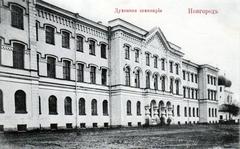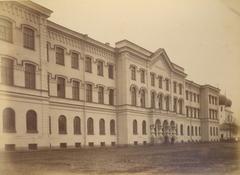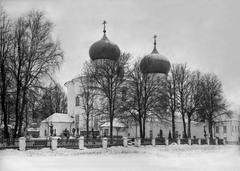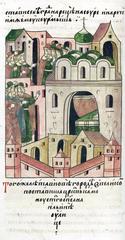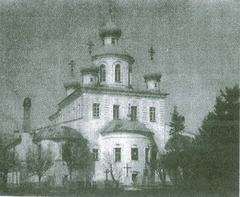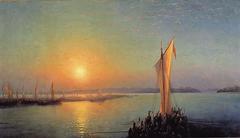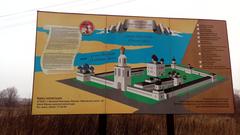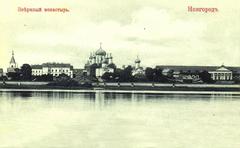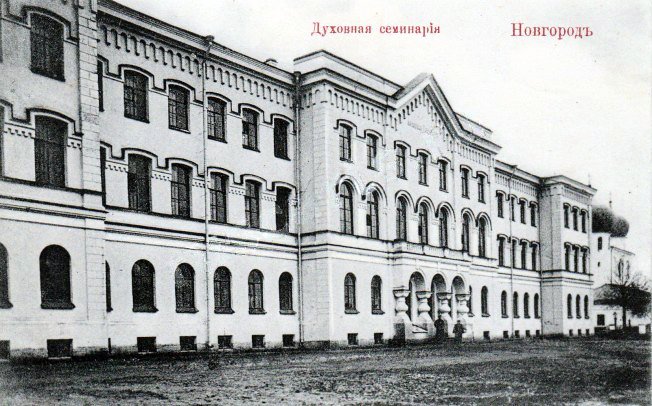
Novgorod Theological Seminary: Visitor Guide, History, Architecture, and Essential Tips
Date: 14/06/2025
Introduction
The Novgorod Theological Seminary, located in Veliky Novgorod, Russia, is a cornerstone of Russian Orthodox education and spiritual heritage. Tracing its lineage to the early 18th century, it has significantly influenced the religious and cultural life of Novgorod, often regarded as the “birthplace of Russia.” This comprehensive guide equips travelers with historical background, architectural highlights, practical visiting information, and recommendations for exploring this remarkable site and its surroundings. Whether you are a history buff, a religious pilgrim, or a curious traveler, the seminary offers a unique window into both Russia’s past and its living Orthodox traditions (novgorod.travel; Travel All Russia; wildtrips.net).
Contents
- Introduction and Significance
- Historical Overview
- Architectural and Cultural Highlights
- Visiting Hours, Tickets, and Accessibility
- Guided Tours, Dress Code, and Visitor Etiquette
- Nearby Attractions and Travel Tips
- Frequently Asked Questions (FAQ)
- Summary and Recommendations
- Sources
Historical Overview
Origins and Development
The roots of theological education in Veliky Novgorod date to 1706 with the founding of the Novgorod Greek-Slavonic School by Metropolitan Job of Novgorod, supported by Peter the Great. This institution, emphasizing Orthodox tradition and excluding Latin, set the tone for Novgorod as a center of Orthodox learning. In 1740, the Novgorod Theological Seminary was formally established under Archbishop Ambrose (Yushkevich) by imperial decree, and initially located at Antoniev Monastery. The seminary quickly developed a robust curriculum and became known for its rich theological library, one of Russia’s finest.
Despite periods of closure, especially during the Soviet era, the seminary was revived in the 1990s and continues its educational mission today, symbolizing the renaissance of religious life in post-Soviet Russia.
Architectural and Cultural Highlights
Exterior Features
The seminary’s main building, constructed in the late 18th century and designed by Vasily Polivanov, is a notable example of Russian ecclesiastical architecture. It features:
- Neoclassical and Russian Revival Styles: The symmetrical façade, arched windows, decorative brickwork, and classical portico reflect 19th-century tastes (Trip.com).
- Functional Layout: Originally designed to house lecture halls, a chapel, dormitories, and administrative offices.
Interior Elements
While general public access to interiors is limited, historical accounts highlight:
- Chapel Adorned with Icons and Frescoes: Central to religious life.
- Lecture Halls and Library: Spaces for theological study and housing rare manuscripts.
Cultural Significance
The seminary has played a pivotal role as:
- A Center for Orthodox Education: Training clergy and lay leaders for the Russian Orthodox Church.
- A Cultural Hub: Hosting lectures, festivals, and music events that reinforce its role in spiritual and community life.
It stands in harmony with Novgorod’s UNESCO-listed historic core, including the nearby St. Sophia Cathedral and Novgorod Kremlin (Travel All Russia; Russiable).
Visiting Hours, Tickets, and Accessibility
Visiting Hours
- General Hours: Monday–Saturday, 10:00 AM–5:00 PM. Closed on Sundays and major religious holidays. Hours may vary during academic sessions and festivals.
- Special Exhibitions: Some areas and exhibitions may have separate hours—always check with the seminary or local tourist information (novgorod.travel).
Tickets
- Entry: Viewing the seminary’s exterior is free.
- Guided Tours: Some tours or special exhibitions may require a ticket or prior booking.
Accessibility
- Mobility: Paths are paved and the grounds are accessible, but some historic interiors may lack full wheelchair access.
- Arrangements: Contact the visitor center in advance for specific accessibility needs.
Guided Tours, Dress Code, and Visitor Etiquette
Guided Tours
- Availability: English and Russian-language tours can be arranged in advance, especially during peak tourist seasons or for special events.
- Booking: Reserve through local tourism offices or the seminary’s administration.
Dress Code & Etiquette
- Dress Modestly: Men should avoid shorts; women are encouraged to wear skirts/dresses and head coverings inside chapels.
- Behavior: Respectful conduct is expected. Remove hats in sacred spaces; silence mobile devices during services.
- Photography: Generally permitted outdoors; indoors, ask for permission—especially during services or in chapels.
Nearby Attractions and Travel Tips
Top Sights Nearby
- St. Sophia Cathedral: Russia’s oldest stone church, famed for its frescoes (visitrussia.com).
- Novgorod Kremlin (Detinets): Impressive fortifications, museums, and panoramic city views.
- Yuriev and Antoniev Monasteries: Architectural gems with centuries-old traditions.
- Birch Bark Museum: Exhibits ancient manuscripts and artifacts (wildtrips.net).
Travel Tips
- Getting There: The seminary is centrally located—reachable on foot or by public transport from the city center.
- Best Time to Visit: Spring and summer for pleasant weather; Easter and Christmas for festive events.
- Combine Attractions: Plan a route including the Kremlin, St. Sophia Cathedral, and the seminary for a complete experience.
Frequently Asked Questions (FAQ)
Q: What are the Novgorod Theological Seminary visiting hours?
A: Monday–Saturday, 10:00 AM–5:00 PM. Closed Sundays and major holidays. Confirm locally for seasonal changes.
Q: Is there an entry fee?
A: General admission for exterior areas is free; tours and exhibitions may require tickets.
Q: Are tours available in English?
A: Yes, especially during peak tourist seasons or by arrangement.
Q: Is the seminary accessible for people with disabilities?
A: Most outdoor areas are accessible, but some historic interiors may not be. Inquire ahead for details.
Q: Can visitors take photographs?
A: Yes, in most outdoor areas. Indoors, always ask for permission.
Summary and Recommendations
The Novgorod Theological Seminary serves as a profound testament to Veliky Novgorod’s enduring spiritual, educational, and cultural legacy. Its storied history, distinctive architecture, and continued religious activity make it a compelling destination. For an enriching visit:
- Confirm the latest visiting hours and ticket policies before arrival.
- Dress modestly and observe local customs.
- Combine your seminary visit with other iconic sites, such as St. Sophia Cathedral and the Kremlin.
- Consider hiring a guide or using an audio tour app for deeper insights.
- Use official tourism resources for planning (novgorod.travel; visitrussia.com).
By following these tips, travelers can fully appreciate the seminary’s role in the spiritual heart of Veliky Novgorod and immerse themselves in the living traditions of Russian Orthodoxy.
Sources
- Visiting the Novgorod Theological Seminary: History, Hours, Tickets & Travel Tips (novgorod.travel)
- Veliky Novgorod: Where Russia Began (Travel All Russia)
- Top 10 Attractions to Visit in Veliky Novgorod (wildtrips.net)
- Guide to Veliky Novgorod (visitrussia.com)
Plan your visit, discover more with the Audiala app for guided tours, and follow us for updates on Russian historical and spiritual landmarks.
